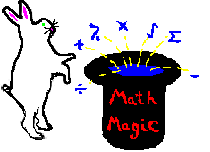 |
||
| HOME
Miscellaneous Elementary Junior High Sum Of Positive Integral Divisors High School Manipulating Polygonal Numbers
|
Finding The GCD (Greatest Common Denominator):A. To find the GCD of 2 numbers, by definition, means to find the highest number that divides evenly into both numbers. Ex [1] Find the GCD of 12 and 18. a. In this example, the number 6 is the highest number that goes into both numbers. Notice that 3 and 2 also divide both numbers, but the GCD is 6. B. There are some steps we can follow to make finding the GCD easier: 1. First, always look to see if the smaller number can divide into the larger number evenly. If it can then the smaller number is the GCD. 2. If not, then to make it easier, we can multiply the smaller number by a coefficient such that both numbers are relatively close. 3. Subtract the two numbers in step 2. This number will be the starting point. If this number can divide into both, then this is the GCD. If not, find a divisor of this number that can. If none can be found or if this number is 1, then the GCD is 1. Ex [2] Find the GCD of 14 and 42. a. Since 14 can divide into 42 evenly, 14 is the GCD. b. The answer is 14. Ex [3] Find the GCD of 12 and 74. a. Since 12 cannot divide into 74 evenly, we need to find a number that when multiplied by 12 gets close to 74. b. If we multiply 12 by 6, we get 72 which is close to 74. c. 74 - 72 = 2. This is our starting point. d. Since 2 divides into both numbers, 2 is the GCD. e. The answer is 2. Ex [4] Find the GCD of 13 and 56. a. Since 13 cannot divide into 56 evenly, we need to find a number that when multiplied by 13 gets close to 56. b. If we multiply 13 by 4, we get 52 which is close to 56. c. 56 - 52 = 4. This is our starting point. d. Since 4 does not go into 13 evenly, we need to find a factor of 4 that does. The factors of 4 are 1, 2, and 4. The only one that divides into both numbers is 1. e. The answer is 1.
|
